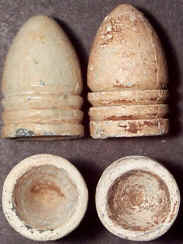
Minie Ball
Perhaps 90% of all battle wounds sustained by either side during the American Civil War were caused by the projectile known as the Minie ball. In 15% of the cases where a soldier was struck by a Minie ball, the wound proved to be fatal.
The projectile was invented by Captain Claude Minie, a French officer. Made of soft lead, it was conical in shape, with three grease grooves along its body.
As the ball usually had a cavity, upon firing, the hot gases produced by the black powder charge expanded into the hollow base of the projectile, forcing the soft lead into the rifling grooves inside the barrel of the musket. These grooves put a spin on the projectile as it traveled the length of the barrel, increasing its range and accuracy.
On both sides, most Civil War cartridges consisted of the Minie ball and black powder enclosed in a paper cylinder. The paper cylinder, full of powder, was placed behind the bullet, and both were wrapped in paper, tied off at the bullet end and twisted at the powder end.
To load the cartridge, the soldier would bit off the twisted end, pour the powder into the barrel, and squeeze the ball from its paper wrapping. A ramrod would then be used to seat the projectile on top of the powder. A percussion cap on the nipple under the hammer would prepare the musket to fire. The Minie ball came in various sizes, from .36 to .69 caliber.
When it struck a human target, destruction of tissues, cartilage, blood vessels, and bone was massive. The soft lead would flatten or break apart as it struck.
If a soldier were hit in an arm or a leg, the projectile would shatter up to 10 inches of bone, requiring amputation under battle conditions. The entrance wound may be the size of a manís thumb, but the exit wound would be the size of a fist. Struck in the torso, a soldier would usually die.
Under todayís conditions, this would not be so, but medical science was not very advanced in the mid-1800s and, under battle conditions, there was little that could be done to repair the damage done by a Minie ball.